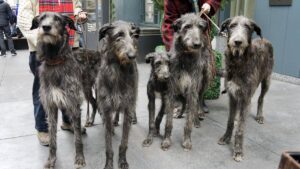
2024 National Tartan Day Parade – A Joyful Event for Scottish Dog Breeds
Discover the joy of Scottish heritage at the 2024 Tartan Day Parade, featuring bagpipers, dancers, and adorable Scottish dog breeds.

Home » Dog Breeds » Scottish Deerhound Dog Breed
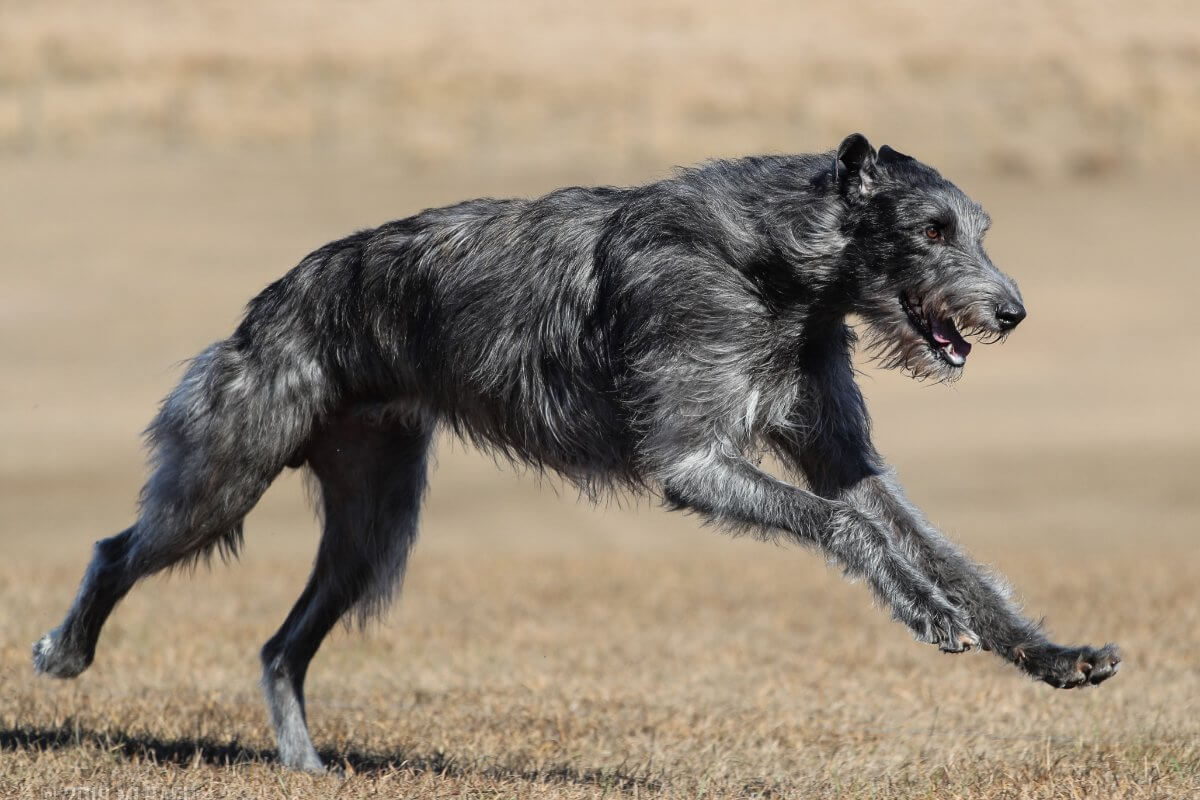
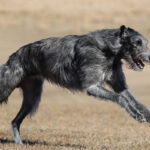
The Scottish Deerhound, sometimes simply known as the Deerhound, is a majestic and ancient breed known for its regal appearance and gentle disposition. Originally bred for pursuing red deer, this sighthound is characterized by a wiry coat, long limbs, and a very dignified demeanor.
Hound
28 – 32 Inches
75 – 110 Pounds
8 – 11 Years
| Country of Origin | Scotland |
|---|---|
| Bred For | Deer Hunting, Companionship |
| Known For | Muscular Build, Gentleness, Loyalty |
| Popularity | Low |
| Temperament | Dignified, Gentle, Polite |
| Activities | Coursing, Running, Hiking, Conformation Shows, Dog Sports |
The Scottish Deerhound, referred to as the “Royal Dog of Scotland,” boasts a history that is as captivating as its regal appearance would suggest. This ancient breed has graced the Scottish highlands for centuries, serving as a trusted companion of nobles and a proficient hunter of fleet-footed quarry.
As a member of the sighthound family of dogs, the breed’s ancestors are believed to have been brought to the British Isles by the Phoenicians and Romans. Those early hounds were interbred with local dogs, resulting in the development of this hound’s coursing predecessors.
The primary purpose of the Deerhound was to course deer, a task for which the hound’s speed, endurance, and size had it ideally suited. Unlike other hunting breeds that relied on scent, Deerhounds used their keen eyesight to spot and chase down their quarry across the rugged Scottish landscape.
By the Middle Ages, the Scottish Deerhound had gained significant prominence, especially among chieftains and nobles. The breed’s prowess in hunting, and their dignified demeanor, made them highly coveted. So much so that, at one point, laws restricted the ownership of Deerhounds to only those of noble birth.
Sadly, as firearms became the preferred method of hunting, the need for Deerhounds diminished. By the 18th century, their numbers had dwindled alarmingly. However, passionate enthusiasts, recognizing the breed’s historical importance and its many unique qualities, undertook efforts to revive the breed.
The 19th century saw a resurgence in the Deerhound’s popularity, thanks to dedicated breeding programs. The breed gained official recognition by various kennel clubs and registries, further securing its place within the dog world. The American Kennel Club (AKC) officially recognized the Scottish Deerhound in 1886, and it was also recognized by the Fédération Cynologique Internationale (FCI) in 1955.
Today, while not as widespread as some other breeds, the Scottish Deerhound is cherished by breed enthusiasts and families alike, not just for its hunting abilities but also for its gentle nature and dedication to its people.
Adult male Scottish Deerhounds typically stand at a height of 30 to 32 inches at the shoulder, while mature females typically measure at least 28 inches tall.
As for weight, males tend to weigh between 85 and 110 pounds, with females weighing slightly less, ranging from 75 to 95 pounds.
Scottish Deerhounds exhibit a harmonious balance between length and height, a proportion that beautifully combines strength and elegance. The breed’s overall body is somewhat elongated, with its length slightly longer than the dog’s height at the shoulders. This gives the Deerhound its characteristic agile and streamlined appearance, one that is perfectly suited for high-speed pursuits. Substance-wise, the Deerhound possesses a robust and athletic build, with strong bones that contribute to its formidable nature while hunting.
Texture: The Scottish Deerhound’s coat is harsh and crisp to the touch. It is thick, close-lying, and rather ragged in appearance. The length on the neck and body, as well as on the fore and hindquarters, measures from 3 to 4 inches in length. A mustache, beard, and eyebrows are present, as is a slight fringe on the insides of the forelegs and thighs. The coat of a Scottish Deerhound provides ample protection in inclement weather.
| Standard Color | |
|---|---|
| Blue Gray | ee |
| Brindle | ee |
| Gray | ee |
| Gray Brindle | ee |
| Black | ee |
| Black Brindle | ee |
| Blue | ee |
Markings: White Markings
A Note About Color: In terms of color, a blue-gray coat is preferred; however, darker and lighter grays and brindles may be seen, the darker the tone the better. Most other historic colors, including black-masked varieties, are no longer seen in the breed. A small amount of white on the chest, the tail tip, and/or the toes is acceptable, but a white collar or white blaze is not.
The tail of the Scottish Deerhound is a distinguishing breed feature, characterized by its long length, tapering form, and curve. Broad at the base, the tail tapers to a fine point and reaches below the hocks. When the Deerhound is relaxed or in motion, the tail is carried low, with just a slight upward curve at the tip.
The tail serves as a good indicator of the dog’s mood, swishing gently when the Deerhound is content and raising slightly when the dog is excited or alert. However, it should not be curled or held over the back. The tail is covered with hair that is slightly longer than that of the neck but shorter than the body coat. It should never be feathered.
Historically, the tail’s length and strength were essential during the hunt, as these qualities aided the hound while it was pursuing its prey. Due to these qualities, however, the tail may be prone to injury in and around the house.
Owning a Scottish Deerhound can be a rewarding experience. This breed, steeped in hunting history with a noble lineage, offers a unique combination of gentleness and strength. However, there are several considerations that potential caretakers should be aware of before deciding to welcome a Deerhound into the home.
The Scottish Deerhound, like all dogs, has specific health concerns that prospective owners of the breed should be made aware. Although these hounds are generally healthy dogs, their large size and unique conformation mean they may be prone to certain conditions.
Lifespan: The average lifespan of the Scottish Deerhound ranges from 8 to 11 years. While some may live beyond these years, it is important to provide the best care to ensure both longevity and quality of life.
While the Scottish Deerhound is a robust and resilient breed, there are certain health risks that should be considered. These include:
Understanding these health risks begins with an honest conversation with a reputable breeder. Regular veterinary check-ups, especially as the Deerhound ages, are also essential as they can help to detect and address any issue before it becomes severe.
When considering the personality of the Scottish Deerhound, one is immediately struck by their gentle and dignified nature. Belying their imposing size, Deerhounds are often described as calm, courteous, and keenly perceptive.
For those wondering if the breed is suitable for novice handlers, the answer is largely affirmative. Scottish Deerhounds, due to their even-tempered disposition, can be quite forgiving of a handler’s missteps. That being said, like all breeds, they benefit from consistent and understanding guidance.
In terms of sensitivity level, Deerhounds are attuned to the emotions and nuances of their human companions. They thrive in an environment of mutual respect and can become withdrawn if treated harshly.
Being alone is something the Scottish Deerhound can tolerate for short periods, but they are social creatures by nature. Extended isolation can lead to feelings of loneliness or even anxiety.
When it comes to relations with other dogs, Deerhounds usually get along well, especially if they are introduced in a controlled and positive manner. Their history as pack hunters means they often appreciate the company of their canine counterparts.
Families with young children will find the Scottish Deerhound to be patient and gentle. However, due to their size, it’s always recommended to supervise interactions between any large dog and small children.
As for their stance towards strangers, Deerhounds tend to be reserved but not aggressive. A well-socialized Deerhound will be polite and may warm up to newcomers once they’ve assessed them.
The nutritional needs of a Scottish Deerhound can vary based on age, activity level, and individual health. However, a balanced diet is the cornerstone for their well-being.
For a Scottish Deerhound puppy, a high-quality puppy formula is essential. As they are a larger breed, growth should be slow to ensure the proper development of bones and joints. Typically, Deerhound puppies are fed 3-4 times a day, transitioning to twice daily feeding as they approach adulthood.
An adult Scottish Deerhound requires a diet that can support its energy levels and size. A typical adult might consume 3-4 cups of high-quality dog food daily, split into two meals. This can fluctuate depending on the dog’s activity level and metabolism.
It’s always crucial for owners to monitor their dog’s weight. Overfeeding can lead to obesity, which in turn can result in numerous health issues. On the flip side, underfeeding or not providing the right nutrients can lead to deficiencies or other health problems.
Treats can be a valuable training tool, but they should be used in moderation. Always ensure that treats are not accounting for more than 10% of their daily caloric intake. Fresh water should always be accessible for the Deerhound, ensuring they stay hydrated.
Lastly, when changing their diet, it should be done gradually over a week to prevent digestive upsets. This involves mixing the old and new food, gradually increasing the proportion of the new food day by day.
The Scottish Deerhound, with its noble lineage and dignified demeanor, might present an impression of independence. However, beneath this stately exterior lies a breed that is eager to please and relatively compliant, making them quite trainable.
That said, Deerhounds, by nature, are gentle souls. They respond best to positive reinforcement methods and can be somewhat resistant to more assertive techniques. The key is patience, consistency, and understanding.
Training a Scottish Deerhound can be a relatively smooth process. Although they aren’t known for being stubborn, their sensitive nature means that handlers should approach training sessions with kindness and positivity. Utilizing treats, praises, and gentle corrections often yield better results with this breed than stern rebukes.
When it comes to vocalizing, Deerhounds are not typically barkers. They might alert their handler to something unusual, but they aren’t known for being overly vocal.
In terms of intelligence, the Scottish Deerhound is sharp and observant. While they might not have the hyper-focus of some working breeds, they are astute and often pick up on cues quickly.
The breed’s wanderlust potential is worth noting. As sighthounds, they have a strong instinct to chase, so it’s essential to provide them with a secure environment. An unenclosed space can be tempting for a Deerhound if they spot something worth chasing.
Regarding predation, their historical role as deer hunters means they have a high prey drive. It’s a trait deeply embedded in their DNA. While they are generally well-behaved and can be trained to recall, it’s always recommended to be cautious when they are off-leash, especially in an area with potential prey.
The Scottish Deerhound, despite its calm and laid-back demeanor indoors, has a deep-rooted need for exercise. As a breed historically bred for coursing deer over long distances, they have retained a significant level of stamina and energy.
| Energy Level | Medium |
|---|---|
| Exercise Requirements | 1 Hour/Day (Minimum), Daily Walks, Vigorous Running, Regular Exercise, Playing with Another Dog, Mental Stimulation |
Their exercise needs are moderate to high. Regular daily walks combined with opportunities to run in a secure area will keep them physically and mentally stimulated. While they certainly enjoy lounging at home, without adequate exercise, they can become restless or even display unwanted behaviors.
In terms of energy level, the Scottish Deerhound is a mix of bursts of speed and long periods of rest. They are known for their impressive sprinting abilities, a nod to their historical role as chasers. When given an opportunity in a safe, enclosed area, they love to stretch their legs in a fast run.
The intensity of their exercise should be balanced. While they benefit from rigorous activity, it’s essential not to overexert them, especially in hot weather. A combination of walks, play sessions, and free runs will ensure they get a well-rounded exercise regimen.
Playfulness is another characteristic trait of the Deerhound. They can be quite spirited and playful, especially during their younger years. Engaging in games like fetch or tug-of-war can be an excellent way for them to expend energy and bond with their human companion.
The unique coat of the Scottish Deerhound, which is a combination of soft undercoat and slightly wiry outer coat, requires a specific grooming regimen to keep it in top condition.
| Coat Type | Harsh, Wiry, Medium Length |
|---|---|
| Grooming Requirements | Weekly Brushing, Occasional Bathing, Routine Ear Cleaning, Periodic Nail Trimming, Regular Tooth Brushing |
Grooming a Deerhound is relatively straightforward. Their coat doesn’t have the tendency to mat or tangle excessively, but it’s still beneficial to brush them once or twice a week. This helps remove loose hairs, keeps the coat clean, and distributes natural oils throughout the fur, promoting a healthy sheen.
In terms of shedding, Scottish Deerhounds are moderate shedders. Regular brushing can help minimize the amount of hair around the home, and during seasonal changes, when shedding might increase, it’s advisable to brush them more frequently.
Beyond coat care, it’s important for owners to regularly check their ears for any signs of infection or wax buildup. Nails should be trimmed every few weeks to prevent overgrowth and potential cracking. Dental hygiene, often overlooked, is crucial. Brushing their teeth or providing dental chews can help prevent tartar buildup and gum disease.
While the Scottish Deerhound doesn’t require frequent baths, it’s beneficial to bathe them when they become particularly dirty or have an unpleasant odor. Using a dog-specific shampoo will ensure their skin doesn’t become dry or irritated.
Living with a Scottish Deerhound is a unique experience, one that’s filled with moments of both calm introspection and playful exuberance. Their majestic and dignified presence often belies their affectionate and gentle nature.
When considering apartment living, the Deerhound can adapt, provided they receive adequate exercise. Despite their size, they are known for being calm indoors, often choosing a favorite spot to lounge. However, given their preference for stretching their legs, a home with a spacious yard is ideal.
In terms of weather adaptability, their wiry coat offers protection from cooler climates, making them well-suited to cold weather. They can enjoy outdoor activities in chillier conditions, but it’s essential to monitor them to ensure they don’t become too cold, especially during extreme conditions. Conversely, in hot weather, care should be taken. Their thick coat can make them prone to overheating. During warmer months, exercise should be scheduled during the cooler parts of the day, and they should always have access to fresh water and shade.
Overall, while the Deerhound can be adaptable to various living conditions, they thrive best when their physical and emotional needs are met. A combination of space to run, regular interaction with their human companion, and a comfortable resting place makes for a content Scottish Deerhound.
Welcoming a litter of Scottish Deerhound puppies into the world is an exciting journey that brings with it an excess of playful antics, boundless curiosity, and the formation of lifelong bonds. These puppies, with their large paws and expressive eyes, are endearing and can quickly capture the hearts of their human companions. They do, however, come with certain responsibilities.
Proper care during a Scottish Deerhound puppy’s early months is crucial to ensure it grows into a healthy and well-adjusted adult. The foundations for its future temperament, health, and behavior are laid during this period.
Nutrition is paramount at this time. Each puppy will have specific dietary needs to support its rapid growth. It is vital , therefore, to provide a high-quality puppy food that meets the nutritional requirements for large breeds. Regular veterinary check-ups will ensure a puppy is gaining weight appropriately and will allow it to receive the necessary vaccinations.
Socialization is another critical aspect of raising a Deerhound puppy. Introducing the pup to a variety of people, places, sounds, and other animals in a positive manner will help it develop into a confident and well-rounded adult. Positive experiences during the early months can shape the puppy’s outlook for the rest of it life.
Training should begin early, even if it is just the basic commands. As mentioned, Deerhounds are sensitive and respond best to gentle, positive reinforcement methods. Building a bond of trust and understanding during puppy training sessions will prove invaluable as the hound grows.
Regular play sessions and moderate exercise are essential for the puppy’s physical and mental development. However, intense physical activities should be limited, as young bones and joints are still developing.
Lastly, setting routines for feeding, potty breaks, and sleep will help the Deerhound puppy to feel secure, and they will aid in housebreaking and crate training.
The Scottish Deerhound, with its rich history of chasing and coursing, naturally excels in activities that tap into its innate talents and energy. While these hounds are not the most hyperactive of breeds, they do enjoy structured activities that challenge both their body and mind. Some of the dog sports enjoyed by Deerhounds include:
Engaging a Scottish Deerhound in various activities and dog sports is beneficial for their physical health, mental stimulation, and the strengthening of the bond between dog and handler. Not only does it offer them a constructive outlet for their energy, but it also allows them to shine in areas where their natural talents are celebrated.
The Scottish Deerhound is recognized by the world’s leading registries and kennel organizations, which categorize the breed into a specific Group based on its unique characteristics. This breed is recognized worldwide under the following Group designations:
| Organization | Group Designation |
|---|---|
| AKC (American Kennel Club) | Hound |
| UKC (United Kennel Club) | Sighthound and Pariah Dog |
| CKC (Canadian Kennel Club) | Hounds |
| ANKC (Australian National Kennel Council) | Hounds |
| RKC (The Royal Kennel Club) | Hound |
| FCI (Fédération Cynologique Internationale) | Group 10: Sighthounds; Section 2: Rough-Haired Sighthounds |
The ideal Scottish Deerhound is described by a Breed Standard that is approved by each of the world’s leading registries and kennel organizations. The Breed Standards for this breed may be found in the following links:
| Organization | Breed Standard |
|---|---|
| American Kennel Club | AKC Scottish Deerhound Breed Standard |
| United Kennel Club | UKC Scottish Deerhound Breed Standard |
| Canadian Kennel Club | CKC Scottish Deerhound Breed Standard |
| Australian National Kennel Council | ANKC Scottish Deerhound Breed Standard |
| The Royal Kennel Club | RKC Scottish Deerhound Breed Standard |
| Fédération Cynologique Internationale | FCI Scottish Deerhound Breed Standard |
Affiliation with breed-specific clubs is essential for both experienced handlers and novices. These clubs often act as a hub for breed enthusiasts, offering resources, events, and a community of like-minded individuals dedicated to the promotion, protection, and appreciation of the Scottish Deerhound.
In the USA, the foremost authority on the breed is the Scottish Deerhound Club of America (SDCA). Established in the early 20th century, SDCA has been instrumental in upholding the breed’s standards, educating the public about Deerhounds, and organizing events that celebrate this majestic breed.
In the United Kingdom, the Deerhound Club stands as the primary organization. Founded in 1886, this club boasts a long-standing history of dedication to the breed. They regularly organize events, shows, and provide a wealth of information for anyone interested in Scottish Deerhounds.
While Scottish Deerhounds are a cherished breed, there are unfortunate instances where these majestic dogs find themselves without a home or in need of rescue. Fortunately, several dedicated organizations and rescue groups work tirelessly to ensure that every Scottish Deerhound gets a chance at a loving home.
In the USA, the Scottish Deerhound Club of America (SDCA) not only champions the breed’s standards and events but also has a dedicated rescue arm. They coordinate rescue efforts across the country, rehabilitating and rehoming Deerhounds in need.
In the United Kingdom, the Deerhound Club has long been at the forefront of rescue and rehoming efforts. They offer assistance to Deerhounds in various situations, from those abandoned to those whose caretakers can no longer provide for them.
Sometimes, breed-specific rescue groups might not be available in certain areas. In such cases, local shelters or generalized dog rescue organizations can occasionally have Scottish Deerhounds up for adoption. It’s always a good practice for potential adopters to check with these entities, as they might come across a Deerhound in need of a forever home.
No, Scottish Deerhounds and Irish Wolfhounds are not the same, although they can be confused due to their somewhat similar appearance. Both breeds have a long history in the British Isles, but they were bred for different purposes. While the Deerhound was primarily used for hunting red deer, the Wolfhound was bred for hunting wolves and for guarding duties.
Yes, Scottish Deerhounds make excellent pets. They are known for their calm and gentle demeanor, especially in a domestic setting. Despite their history as hunting dogs, these hounds are affectionate and good-natured, and they can get along well with children and other animals when socialized properly.
No, Scottish Deerhounds are not considered hypoallergenic. They have a wiry coat that sheds moderately. While no dog is truly hypoallergenic, some breeds produce fewer allergens than others. The Deerhound is not generally listed among hypoallergenic breeds.
Scottish Deerhounds, like many dogs, can swim, but it is not a breed that particularly enjoys or excels at the activity. As with all dogs, if introduced to water in a positive manner, the hound might take to it. However, it is important that all safety precautions are taken when introducing any dog to water.
Yes, Scottish Deerhounds do shed. The breed’s rough and wiry coat sheds moderately throughout the year. Regular grooming and brushing can help to manage the shedding and to keep their coat healthy and free of debris.
Scottish Deerhounds are large dogs. Adult males can stand 30 to 32 inches tall at the shoulder and weigh between 85 and 110 pounds, while females typically stand 28 inches or more at the shoulder and weigh between 75 and 95 pounds. The Deerhound’s tall and slender build contributes to its elegance and grace.
Scottish Deerhounds are incredibly fast runners, owing to their history as a coursing hound. They can reach speeds of up to 35 miles per hour. Their long legs and lean build make them well-suited for sprinting over open terrains.
Scottish Deerhounds have a typical lifespan of 8 to 11 years. As with all dogs, proper care, nutrition, and regular veterinary check-ups can contribute to a longer, healthier life. It is worth noting that larger dog breeds generally have shorter lifespans than smaller breeds.

Discover the joy of Scottish heritage at the 2024 Tartan Day Parade, featuring bagpipers, dancers, and adorable Scottish dog breeds.
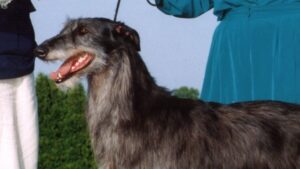
Interview with Barb Heidenreich, breeder of Fernhill Scottish Deerhounds. Read about the kennel’s beginnings, achievements, and much more!
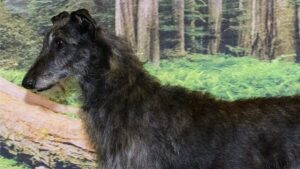
Explore the legacy of Scottish Deerhounds, reflecting on the breed’s beauty, athleticism, and history of lure coursing and show rings.
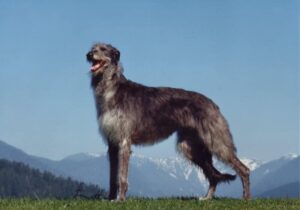
The Scottish Deerhound, often known as the Deerhound, is a large sighthound breed that was originally developed for coursing red deer.
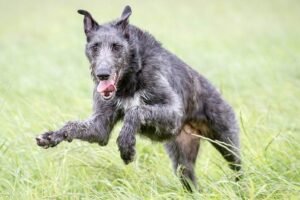
Interview with Hound Group Breeder Lynne Lozano – Iron Gate Hounds – My kennel name is Iron Gate. I currently have 10 Scottish Deerhounds on
The best way to ensure a long and happy relationship with a purebred dog is to purchase one from a responsible breeder. Not sure where to begin?
Contact the National Parent Club’s Breeder Referral Program, which is listed on the AKC Breeder Referral Contacts page.
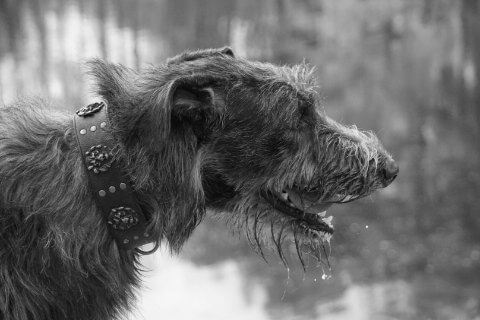

"*" indicates required fields
Showsight Magazine–the world’s most influential purebred dog publication since 1992. Each issue reaches a global audience dedicated to preserving the history and health of purpose bred dogs. Filled with award-winning editorial focused on news and insights from the dog show community, top breeders, handlers, AKC Judges, and more!